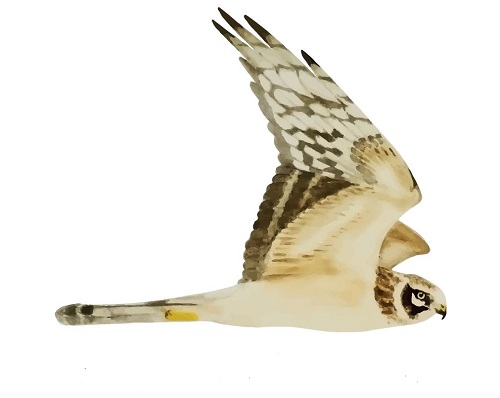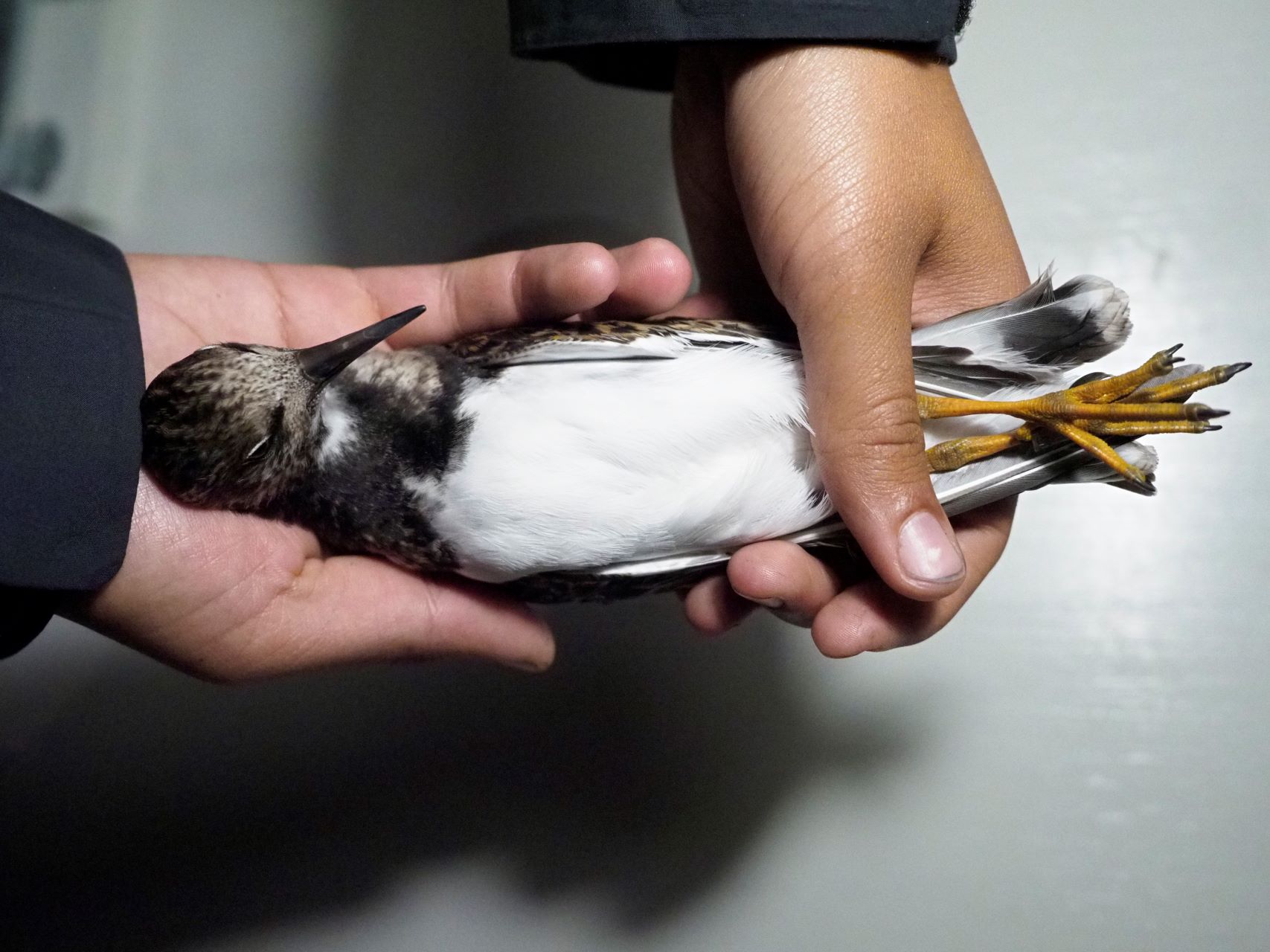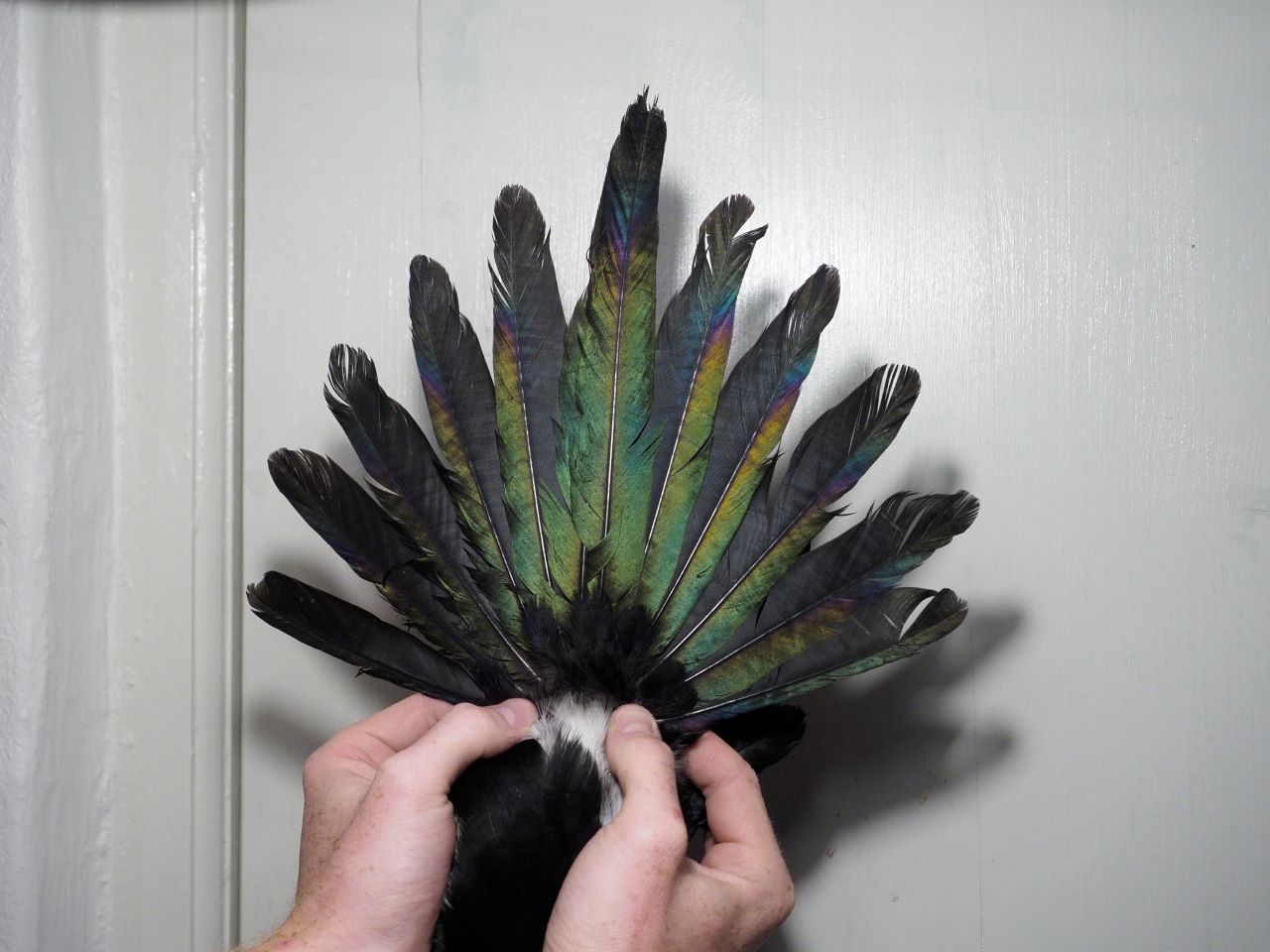Her på Skagen Fuglestations blog bringes korte nyheder i dagbogsformat om hændelser på fuglestationen.
Se indlæg fra måned: feb. (11)mar. (31)apr. (30)maj (31)juni (30)juli (31)aug. (31)sept. (30)okt. (31)nov. (30)dec. (6)
Wader Counting at Jerup and Fulmar survey!
Hi everyone,
today was, once again, too windy to open the nets, so we decided to put some effort on seawatching and bird counting. Diana, Aksel, Simon, and later Johanna went to World End 3 for seawatching with Knud, where they saw a Sooty Shearwater „Sordfarvet Skråpe”– we are definitely grateful to see so many Procellariidae these last few days ! They also had a Great Skuas „Storkjove”, and spent some time detailing the shorebirds to be able to better identify them on the field.
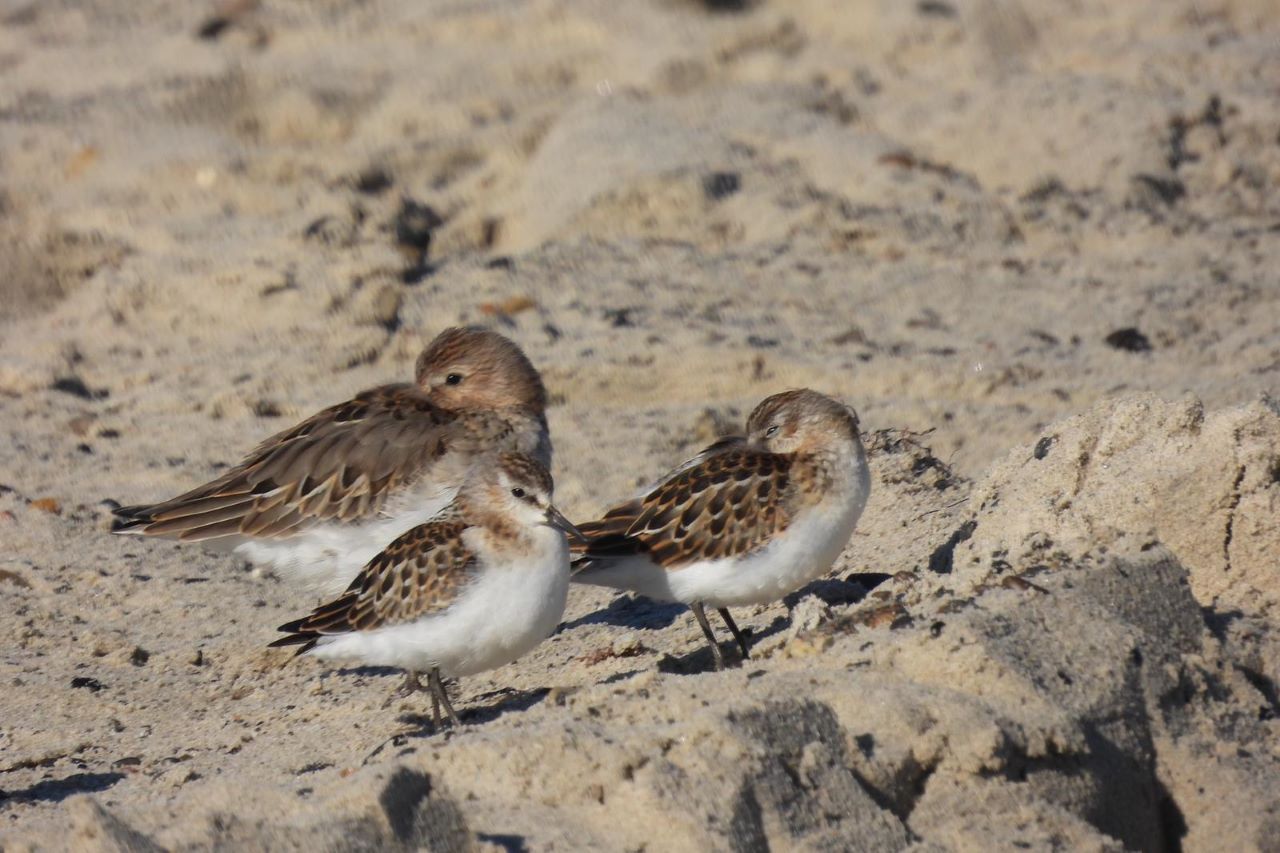
Dunlin "Almindelig Ryle" in the back and Little Stint "Dværgryle" in front
In the afternoon, Simon dropped them at Gammel Skagen for a 10 km long Fulmar "Mallemuk" survey : the goal is to collect dead Fulmars "Mallemuk" in order to study the amount of microplastic contained in their stomach. They found on sadly encountered dead 37 Gannets, six Guillemots „Lomvie”, one Razorbill „Alk” and one Sandwichtern ”Splitterne“. Along the way, in honor of the World Clean Up Day that happened last week on the 17 of September, but also because we care about the safety and health of our seabirds, they collected 4 kg of waste along the shore – mostly transparent plastic, that seabird might mistake with jellyfish, and fishing ropes, in which seabirds can get entangled.
In the meantime, Solenn and I had a very different day. In the morning went with Rie to Jerup Strand to look at waders ; we had good numbers of Dunlins „Almindelig Ryle“ and Oystercatchers „Strandskade“, and happily identified Bar-tailed Godwits „Lille Kobbersneppe“ and one single Greenshank „Hvidklire“ ; on the way back, we had some Ruffs „Brushane“ on a field and very good views on a sparrowhawk that decided to rest for a moment on a pole.
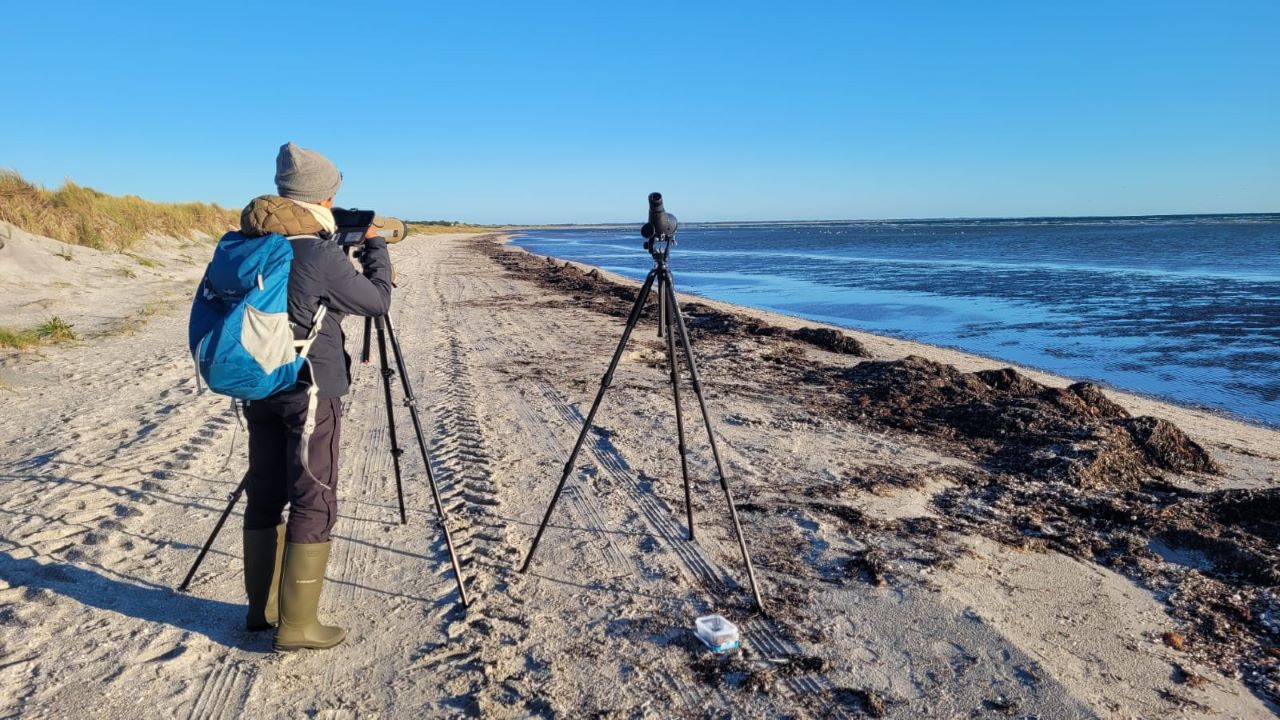
After our nap, I continued analysing the nocturnal migration recording while Solenn entered the observation data and started cooking dinner and baking some biscuits and cookies, which hopefully will help Diana and Johanna to stay awake tonight as they have the nightwatch today for our stormie + nightjar night catching session. We´ll ceep you updated on the results of that session!
While Diana and Johanna will probably be sleeping tomorrow morning, Solenn, Aksel and I will be in the field, so see you tomorrow!
Observations of the day in DOFbasn from observers in the area
Hanelie
People at the station: Simon Christiansen, Lisa Vergin, Knud Pedersen, Rie Voertmann, Diana Sciandra, Hanelie Sidhu, Solenn Boucher, Johanna Veentjer, Aksel Munkholm
Scopoli's day 4
Hi everyone,
The weather definitely doesn’t wish us luck recently ; the morning was very windy again, enough to keep our nets closed for the third day in a row. All five of us therefore took our chances and went to Verdens Ende 3 with Knud, who returned yesterday afternoon, and managed to see the Calonectris sp. individual ! This presumed Scopoli’s shearwater Scopolis's skråpe has been around for the last four days, and went close enough to the beach today to allow all of us to have a good glance at it, specifically the light underwing – a criteria to distinguish it from its sister species, the Cory’s shearwater Kuhls skråpe.

We also saw a great skua Storkjove attacking two grey herons Fiskhejre – not to eat them, but to feed on their prey. This behaviour is called kleptoparasitic foraging : if skuas rely heavily on this type of foraging, some other species like gulls måger can do it opportunistically. It also exists in other mammal and arthropods species, like hyenas hyæner.
At the pond, near the tip, there were some common terns Fjordterne resting; one Arctic Tern Havterne was sitting next to one of them and it was therefore easy to see that the Arctic Tern has shorter legs and bill than the common one.
After two hours of wind blowing sand all the way up to our faces, Diana, Johanna and I decided we froze enough at the beach and went to Cormorant’s lake instead, where we could see ruffs Brushane, dunlins Almindelig Ryle, snipes Dobbeltbekkasin, grey plover Strandhjejle and little stints Dværgryle – before a sparrowhawk Spurvehøg scared all the birds away from the lake, at which point we went back home while eating Havtorn fruits collected on the way.

In the meantime, Knud explained Hanelie and Aksel the visual clues to distinguish juvenile gulls ; he also pointed out the fulmars Mallemuk far out at sea, and their specific « jizz », i.e. the combination of the general shape of the bird (big/small, elongated/round, pointy or round wing shape, etc) and its way of flying (soaring / flapping its wing constantly, up and down / straight, close to the water / high in the sky, etc).
After lunch and nap, we spent the afternoon entering or checking datas. Then everybody went back out again, for birding along the shore (Aksel took a swim in the sea !) or at Cormorant lake, while I was analysing nocturnal migration – or at least tried to, as there was a lot of parasitic noise on the recordings, such as TV, human voices, cars, and high level of background noise.
We will now enjoy some home-made pizzas and Scopoli’s cake Johanna made for us – have a nice evening !

People at the station: Diana Sciandra, Hanelie Sidhu, Solenn Boucher, Johanna Veentjer, Aksel Munkholm, Knud Pedersen
Great Skuas in the evening
Hi everyone!
The day started quite slow for us, as the weather was too rainy and windy to go ringing. Luckily the weather became better late in the the morning and Solenn and Aksel went to Worlds end 3 for observations. They saw a Golden Plover (Hjejle), Common Terns (Fjordterner) and Razorbills (Alk). Aksel saw his first Red-throated Divers (Rodstrobet lom)!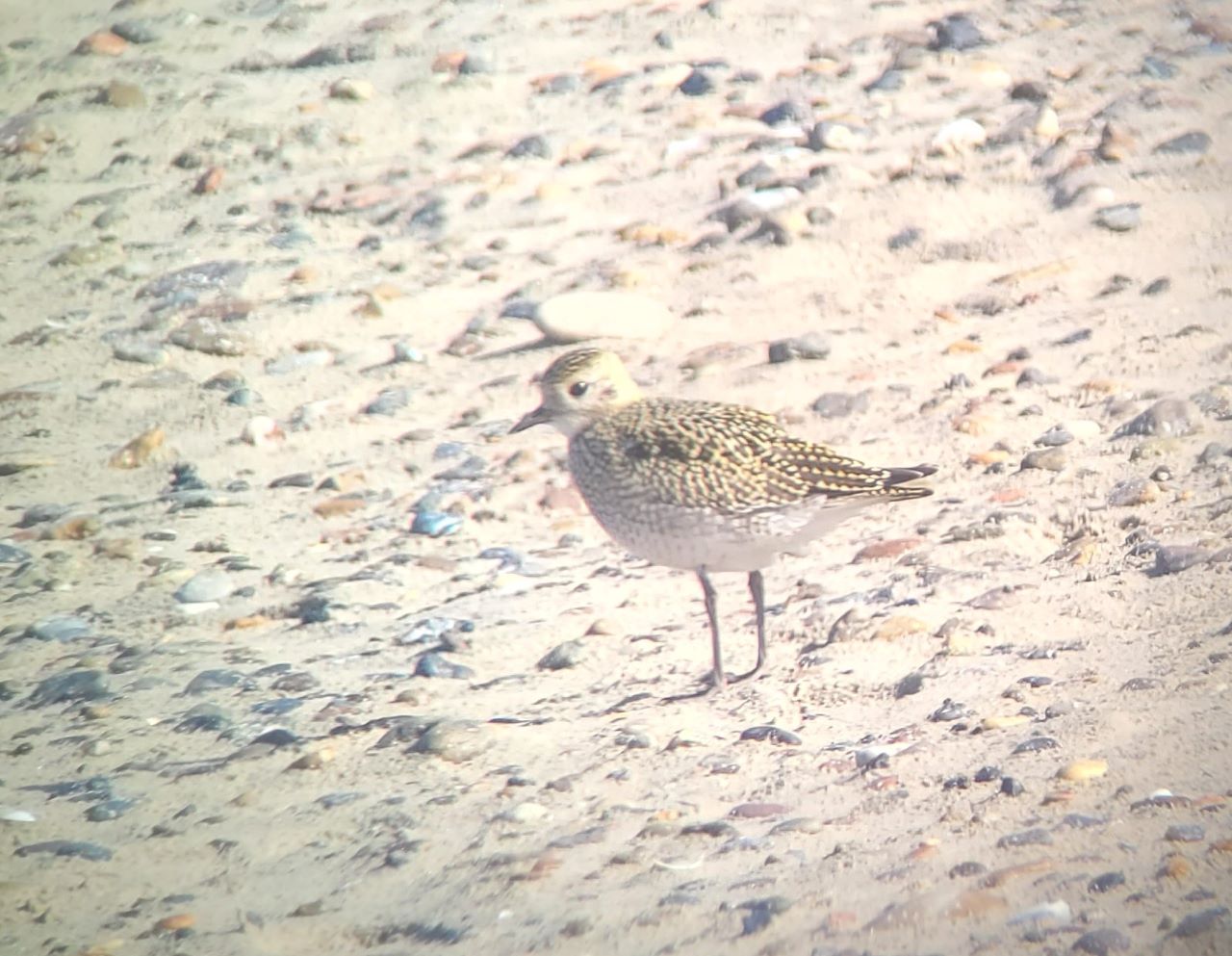
I joined them later and then went back to the station with Solenn, while Aksel stayed at the observation point and was joined by Diana then. She also made some beautiful paintings of birds today as you can see in the picture below.
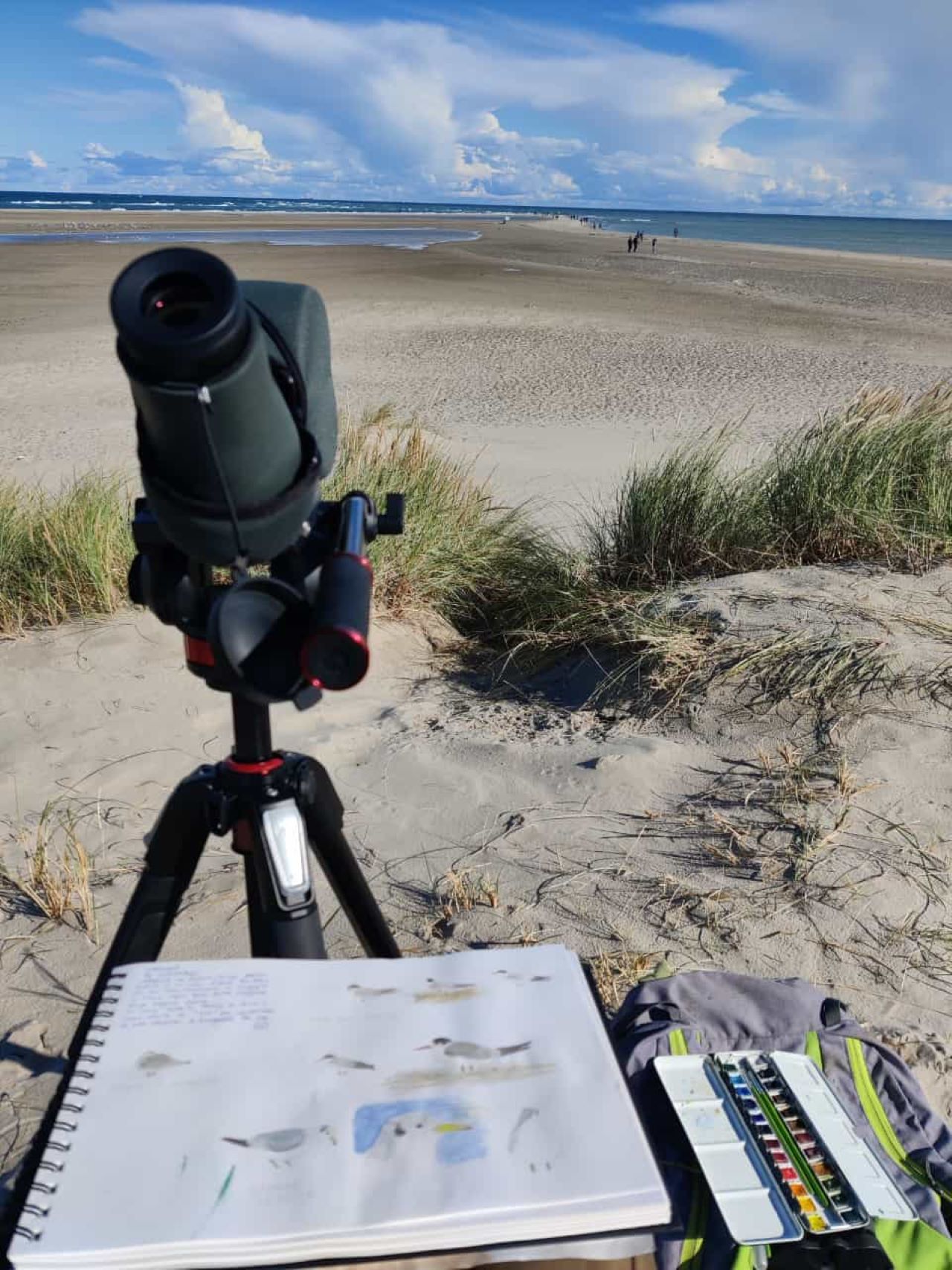
Hanelie went to Batteriskoven in the afternoon and she saw two Great Spotted Woodpeckers (Stor Flagspætte), a lot of Chaffinches (Bogfinke), Crested Tits (Topmejse), Siskins (Grønsisken), a Eurasian Treecreeper (Træløber), a lot of Goldcrests (Fuglekonge) and Great Tits (Musvit) as well as Blue Tits (Blåmejsen). Then she went to the industrial area and saw some Goldcrests (Fuglekonge) and Yellowhammers (Gulspurv) and a bit further on the horse fields four Lapwings (Vibe) and also four Common Snipes (Dobbeltbekkasin) in a ditch. Afterwards she went to Grenen near the tractor track and met Knud and some other birders there and they saw the Scopoli’s Shearwater ( Scopolis's skråpe) and two Great Skuas (Storkjove).
Solenn, Aksel and I did some data work in the afternoon. We were interrupted by some people who brought a Common Kestrel (Tårnfalk) they had found in the street ; the bird was probably hit by a car. We put it in a card box in a cool spot and called the animal protection (1812) who could take better care of the bird ; one of their volunteers picked it up two hours later, hopefully to its full recovery.
People at the station: Diana Sciandra, Hanelie Sidhu, Solenn Boucher,Johanna Veentjer, Aksel Munkholm, Esben Hansen
Kalibrering til fugletid
Hej allesammen
I dag har været min første fulde dag her på Skagen fuglestation. Dagen startede kl. 5 (liiidt tidligere end hvad jeg er vant til) hvor nettene fra nattens forsøg på at fange stormsvaler skulle pilles ned. Herefter dragende Esben, Solenn og jeg afsted mod kabeltromlen for at starte dagens ringmærkning, mens Johanna og Hanelie stod for morgenobs.
Vinden var ikke med os i dag, så det var lidt en sløv dag ved kabeltromlen. Vi endte med i alt at ringmærke 19 fugle og en genfangst. Det lave antal fugle betød dog, at der var bedre tid til den enkelte fugl, hvilket var dejligt for en ny ringmærker som mig. Jeg fik lært en masse omkring fældning og kønsbestemmes og fik også selv ringmærket et par fugle til sidste på formiddagen, heriblandt en gulspurv (yellowhammer).
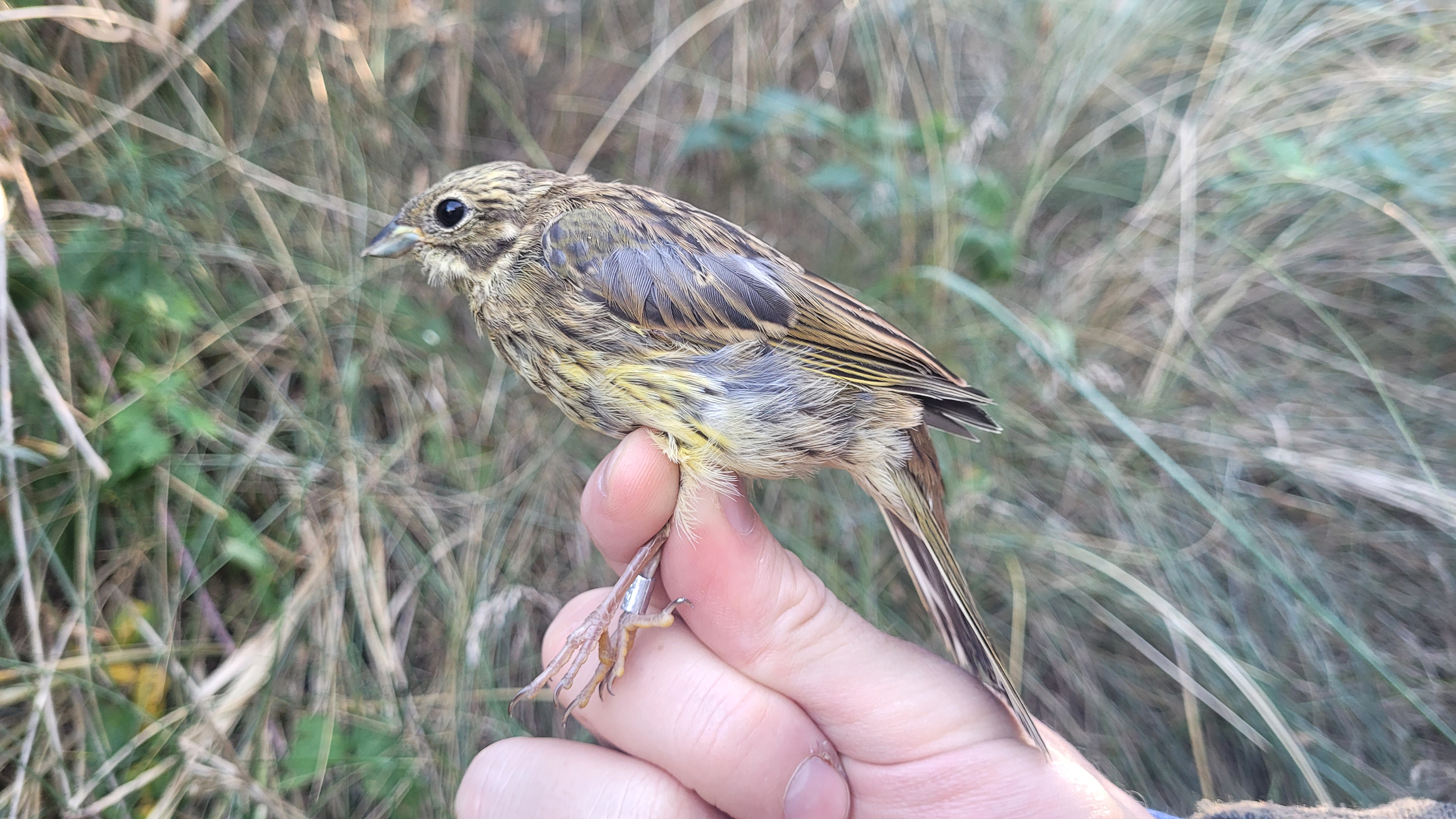
For observationsholdet var det også en blandet fornøjelse i dag. Igen i dag blev Kuhls skråpen (Scopoli’s Shearwater) spottet ud fra kysten, og observationsholdet forsøgt om de kunne spotte den. De missede den dog akkurat, men vi krydser fingre for at der er en mulighed igen i morgen.
Efter hjemkomsten fra ringmærkning stod det på en omgang frokost og en dejlig lur. Da jeg vågnede fra min lur, besluttede jeg mig for at udnytte det godt vejr og valgte at følge menneskestrømmen ud mod grenen. Det syn bliver man nu aldrig træt af. Resten af eftermiddagen blev brug på rengøring og indtastning af data på stationen.
I anledning af Simons mors fødselsdagsfejring var der også arrangeret fremvisning af ringmærkning samt en tur til bunkeren med Hanelie som guide.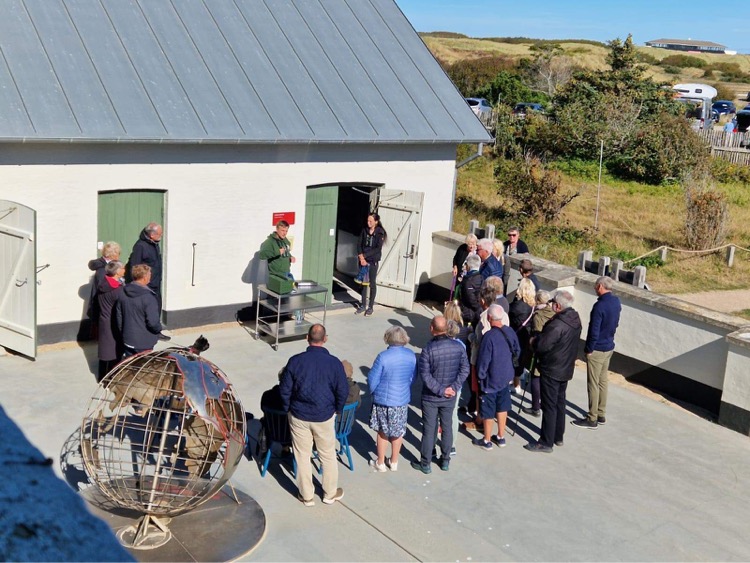
Jeg vil nu lægge skivepinden fra mig og gå til køjs, mens jeg krydser fingre for at vi undgår alt for meget regn og blæst i morgen tidlig.
Fugle ringmærket ved kabeltromlen:
Fuglekonge: 5
Gransanger: 7
Rødhals: 1
Rørspurv: 2
Dompap: 1
Munk: 1
Gulspurv: 2
Total: 19
People at the Station: Diana Sciandra, Hanelie Sidhu, Solenn Boucher, Frank Osterberg, Johanna Veentjer, Aksel Munkholm, Simon Christiansen, Lisa Vergin, Esben Hansen
Today’s Observations from the area on DOFBasen
Shearwater’s day
Yesterday has been a very exciting day, for all of us! Both ringing and observing have been very successful. I went ringing with Hanelie and Simon and we caught 71 birds and also caught 5 birds which have been previously ringed: recaptures are always super interesting, also if the birds were ringed in the same ringing station. Between the 76 birds checked today there was a super cute group of 8 Long-tailed tits (Halemejse; picture above); one of them was a recapture, and me and Solenn discovered that the bird was ringed by Skagen Fuglestation in Kabletromle in June!
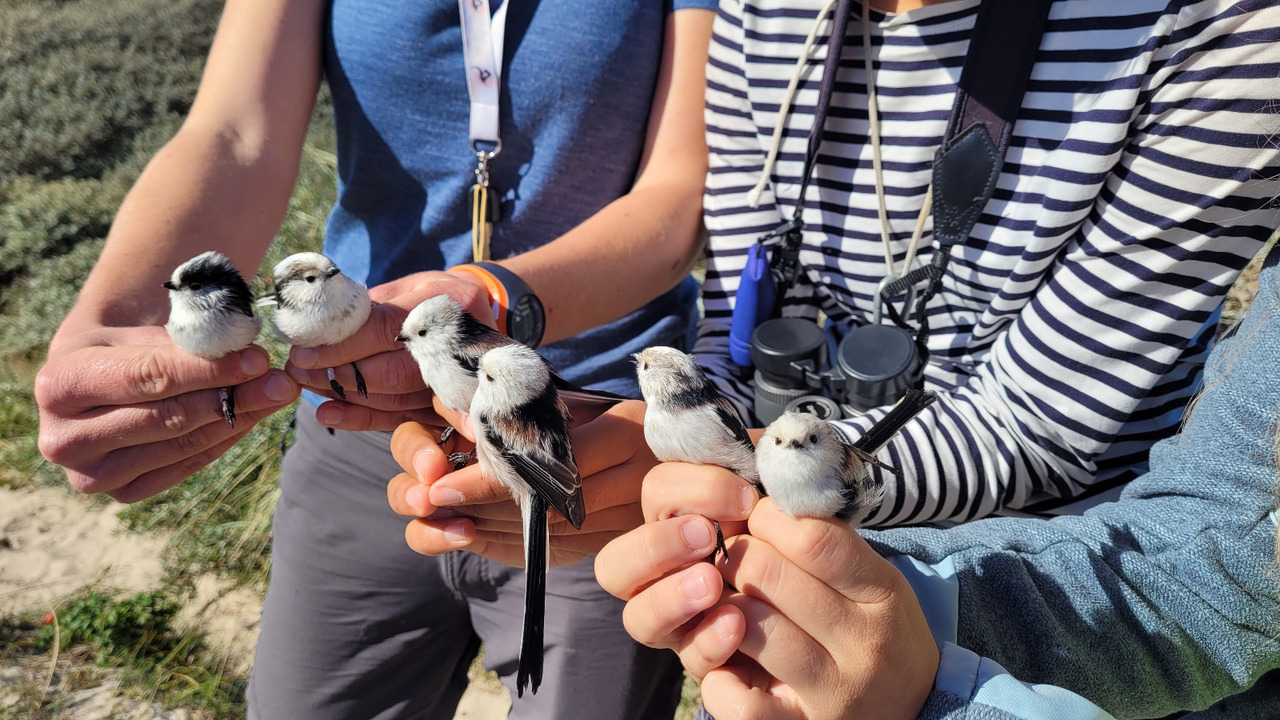
Today we saw 14 different species of bird at the ringing table and it has been very didactic for me and Hanelie: for the last rounds also Solenn and Frank joined us. They were very happy about their morning: at Grenen they saw hundreds of Fulmars (Mallemuk) and 4 Sooty Shearwater (Sodfarvet skråpe)!
The sea had another (bigger) surprise for the evening: a Scopoli’s Shearwater (Kuhls skråpe)! Me, Hanelie and Johanna ran at the tip to try to see it (at the same moment Simon was seeing it from the lighthouse and he helped us from there to locate the bird). We managed to see it, Hanelie found the bird by herself, when I was running towards Erik Christophersens and Rolf Christensen, two birdwatchers who helped me to find and observe the bird (Erik let me use its scope to observe the bird; thank you very much! In the picture above you can see one of the beautiful pictures he managed to take yesterday while I was there), and it was the first time she observed this species (usually common in Mediterranean sea)!
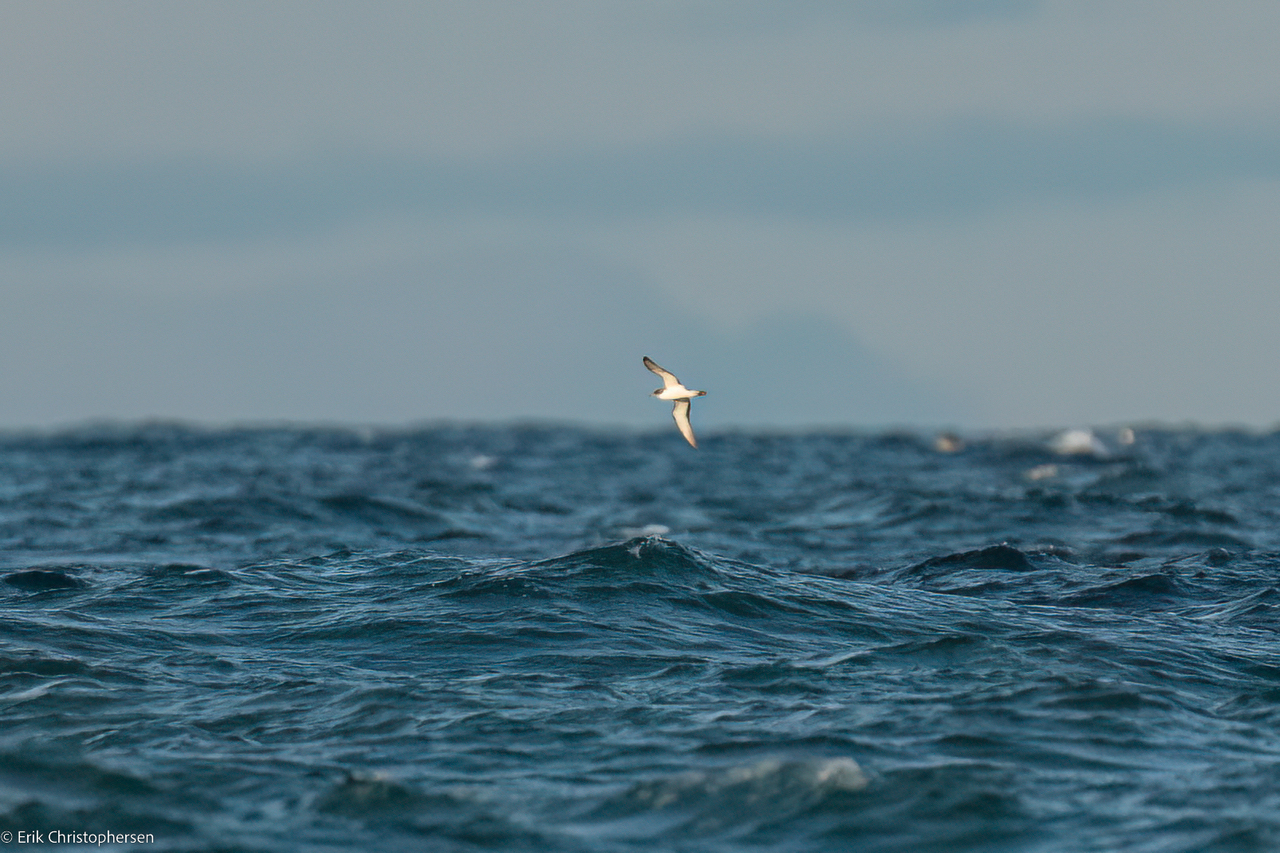
Picture by: Erik Christophersen
It has been a wonderful day, and, moreover, at the Skagen Observatory arrived two new volunteers: Johanna, who will stay here for two weeks, and Aksel (who will stay until December). Also Esben joined us yesterday, to help us with ringing in the next days.
Ringing totals at Kabeltromle:
Fuglekonge: 10
Gransanger: 17
Halemejse: 8
Traløber: 1
Rødstjert:1
Rødhals: 15
Gærdesmutte: 8
Rørsanger: 1
Gærdesanger: 1
Broget fluesnapper: 1
Munk: 5
Tornsanger: 3
Rørspur: 1
Stor flagspætte: 1
Musvit: 1
Totals: 74
People at the Station: Diana Sciandra, Hanelie Sidhu, Solenn Boucher, Frank Osterberg, Johanna Veentjer, Aksel Munkholm, Simon Christiansen, Lisa Vergin, Esben Hansen
Wader Sexing and Ageing by Mr. Osterberg!
Hi everyone!
Today was the last day that we had company from Martina and her school class. But although they had to pack down their tents in the morning, they visited the different groups visited us at Kabletromle and at Verdens Ende 1. Frank and Solenn were Ringing today and Lisa joined them for a while. Unfortunately, she left before the Great Sptted Woodpecker in the last round which was the highlight of todays ringing. Solenn was very happy to ring it although it pecked her fingers quite hard. Diana and I went to Verdens Ende 3.
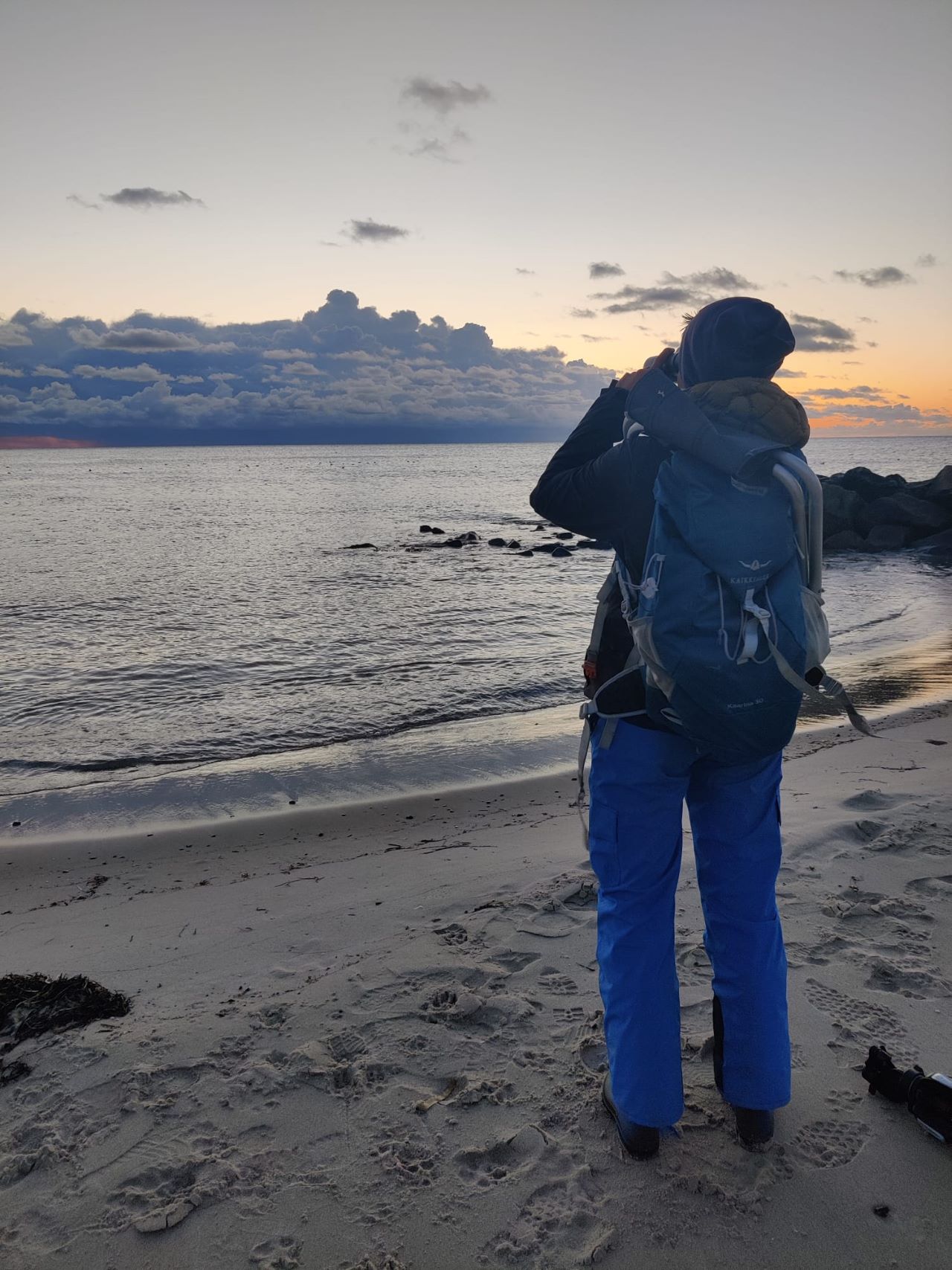
Right when we arrived, there was a Bar-tailed Godwit „ Lille Kobbersneppe“ restig at the tip which was a nice start for the morning. In the first hour we also had a Fulmar „Mallemuk“ which was the highlight of the observations for Diana as it was her first Fulmar „Mallemuk“! In the secound and third hour Martina and a group of students joined us. They were looking at the Scoters „Sortand“, Gannets „Sule“, of which there were also many again today as well as the waders resting on the beach: Sanderlings „Sandløber”, Dunlin ”Almindelig Ryle”, Red Knot ”Islandik Ryle”, Little Stint ”Dværgryle”.
Diana also went to read some rings in the last hour of the observations. Then we went back, entered the data and had lunch. And it was finally time to say goodby to our guests from Hamburg and to take a last group picture in the yard. We hope they had a safe travel home.
In the afternoon we all had a nap apart from Frank, who was still preparing his presentation about Shorebird ageing and sexing. At four, the session finally started, now we are all a bit smarter and hope we can also use our new skills in the field. Mange tak, Frank!
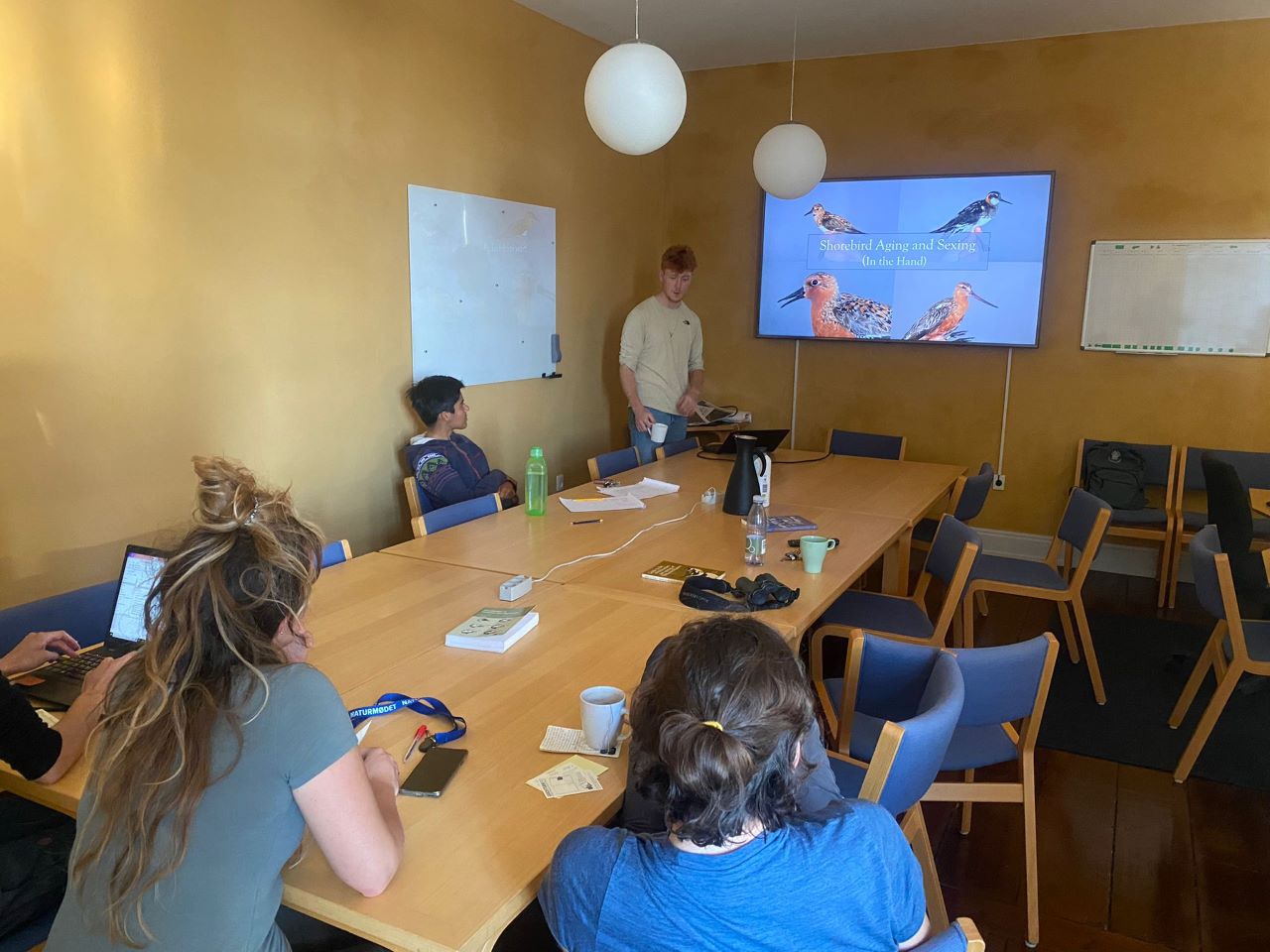
After the evening meeting Frank, Solenn and I went to the cormorant lake to check how manz waders were there. There were not many but a Grey Plover ”Strandhjejle” and two Garganeys ”Atlingand” were nice. On the way back Frank went to Ellekrattet and Solenn and me went to Batteriskoven but we just heard some Goldcrests ”Fuglekonge”. When we came back, Frank was waiting for some German Tourists who found a injured Gull on the beach. The gull turned out to be a Fulmar ”Mallemuk” but it was in a very condition and died a few minutes after it was brought to the bird observatory. Diana had cooked dinner today, Simon and Lisa joined also.
Tomorrow we´ll be out again, see you in the field! Take care, Hanelie
Observations of the day in DOFbasn from observers in the area
Ringing totals at Kabeltromle:
Fuglekonge: 6
Gransanger: 4
Rødhals: 4
Lille Gråsisken: 1
Jernspurv: 1
Rørsanger: 1
Munk: 2
Tornsanger: 1
Musvit: 1
Stor Flagspætte: 1
Totals: 22
People at the Station: Frank Osterberg, Solenn Boucher, Diana Sciandra, Simon Christiansen, Lisa Vergin, Hanelie Sidhu, Martina Hillbrand
Gannets everywhere !
I will first leave the keypad to Emma, one of the students visiting us :
“Today was our third day at the Skagen Fuglestation and my group’s turn to go birdwatching. We left for the beach in the north, where the North Sea and the Baltic Sea meet, and kept an eye out for certain types of birds whilst the sun rose : gannets Sule, lesser black-backed gulls Sildemåge, common scoters Sortand and barn swallows Landsvale – although we only managed to see 3 of those, way less than in the previous days.
At the beach we were confronted with multiple weather factors that had taken influence on the number and types of birds we were able to see. On this particular morning, there were more waves than the last few days, which for one attracted gannets Sule, but also flooded the beach more, which lead to the gulls having less space to rest. There were also stronger winds, making the tip of the beach less attractive for resting common scoters Sortand, so we saw fewer of these too. We were however able to see a great number of sanderlings Sanløber, up to a few meters close to us! A special and exciting experience we dauntingly embraced.

All in all, Skagen is a fantastic location to learn about bird migration; we shared many unique first impression of bird migration, either on the sand bank between the two seas or between the dunes with Diana and Hanelie, also keeping an eye out for birds from inland.”
Because of the wind, today has also been a very slow day for ringing ; only 11 birds of 4 different species have been visiting our nets, forcing us to close only 3 hours after the start. Frank and I therefore had a lot of time to discuss ringing with the students.
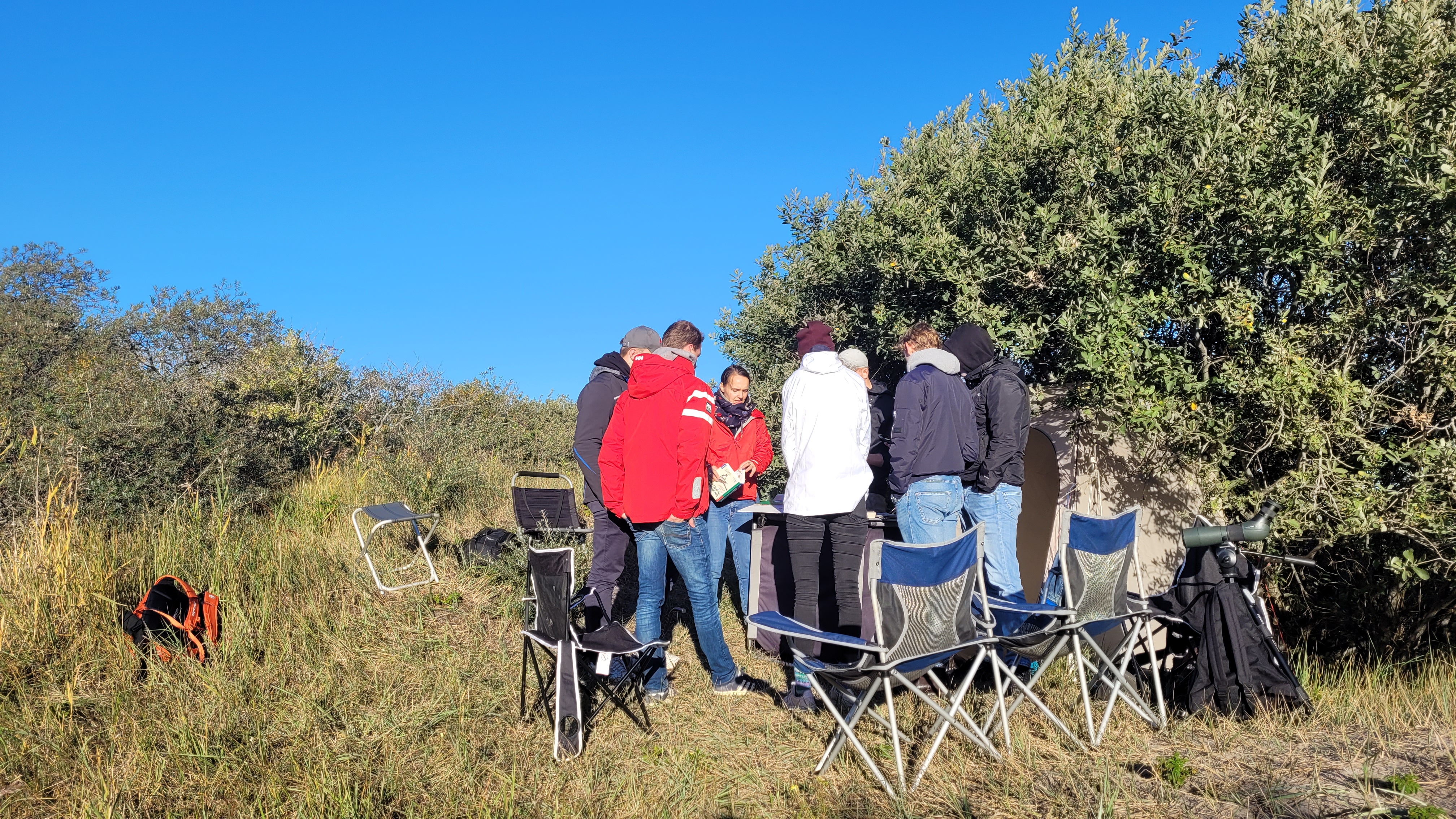
After we entered the data with the students this afternoon, and cleaned the optic equipment that was exposed to sand these last windy days, Frank worked on his presentation while I read more about bird migration and Hanelie showed Diana how to analyse nocturnal migration recordings. Diana and I have a great deal to learn about migrating bird calls !
Simon took a glance at bat diversity around Skagen lighthouse, thanks to nocturnal bat recordings from the garden ; hereafter is an example of a soprano pipistrelle Dværgflagermus, recognizable by the high frequency of its calls (above 57 kHz), recorded in the night from the 1st to the 2nd of September.
We also said goodbye to our two guests Kristin and Carl, pictured below with our volunteers ; thank you for visiting us, we hope you had a great time !
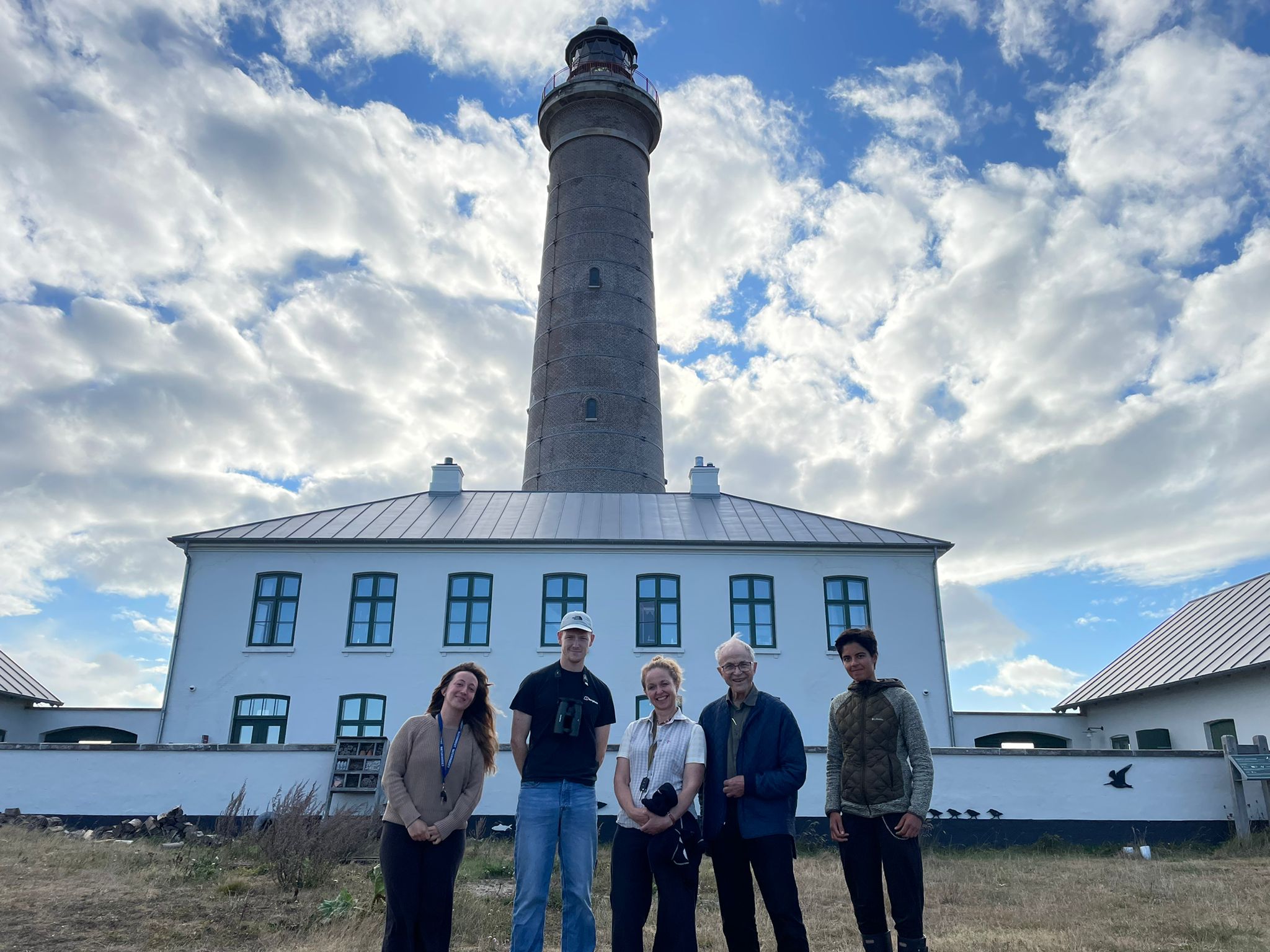
People at the Station: Solenn Boucher, Frank Ostenberg, Diana Sciandra, Hanelie Sidhu, Simon Christiansen, Lisa Vergin, Martina Hillbrand and her students, and our guests Kristin and Carl.
Ringing (Kabeltromlen)
Goldcrest / Fuglekonge : 1
Robin / Rødhals : 4
Blackcap / Munk : 3
Garden Warbler / Havesanger : 1
Cory's Shearwater!
First, a short extract From Elisabeth and Helene who were part of the ringing group yesterday but were out observing this morning:
“Today is our second day at the Bird Observatory in Skagen.
Yesterday, we were invited to help and learn about the bird-ringing, which was an action-packed and fascinating experience. We caught many birds due to the optimal weather. The volunteers showed us the local bird species, their different features and were engaged to answer our questions. It was a great day to start the week with and to gain a first impression.
This morning we woke up at 5:15am and walked to the tip, where the two seas (north-and Baltic seas) meet each other. Just as we arrived, we saw a beautiful rainbow on the sky opposite the sunrise. It was a remnant of the rain of last night and a predictor of what was to come. It was cold and windy, but we managed to identify several groups of birds. For instance, the gannets (Sule), which dived deep in the water to fish. There were much more than yesterday; we counted to 600. After about one hour, we got rained on quite a bit and since there is no cover everybody got really wet. Persevering, we stayed out anyways to continue our counts of migratory birds. Among them we saw several red-throated divers (Rødstrubet Lom) both flying and sitting in the water. Some of them were still in breeding plumage and we got a very good view of them, which was nice. Towards the end of the morning, we got a really special sight of a Merlin (Dværgfalk) who was perched on the beach. We couldn’t see if it had any prey but after a few minutes it flew off again. After that we left because at the tip with the wind blowing and all of us quite wet it got really cold. Solenn and Diana stayed to continue the count while we walked back towards the campground. On our way we stopped at the tent where the other group was still busy with the ringing.
There, Frank showed us a bird that we hadn’t caught yesterday. It was a juvenile Redpoll (Lille Gråsisken) that had found its way into the net just before we arrived.
After lunch we went in search of barn swallows (Landsvale) and found a few but not nearly as many as there were yesterday. Then we helped with the data entry and started writing our reports of the week.
From Elisabeth and Helene”
Now from the stations view;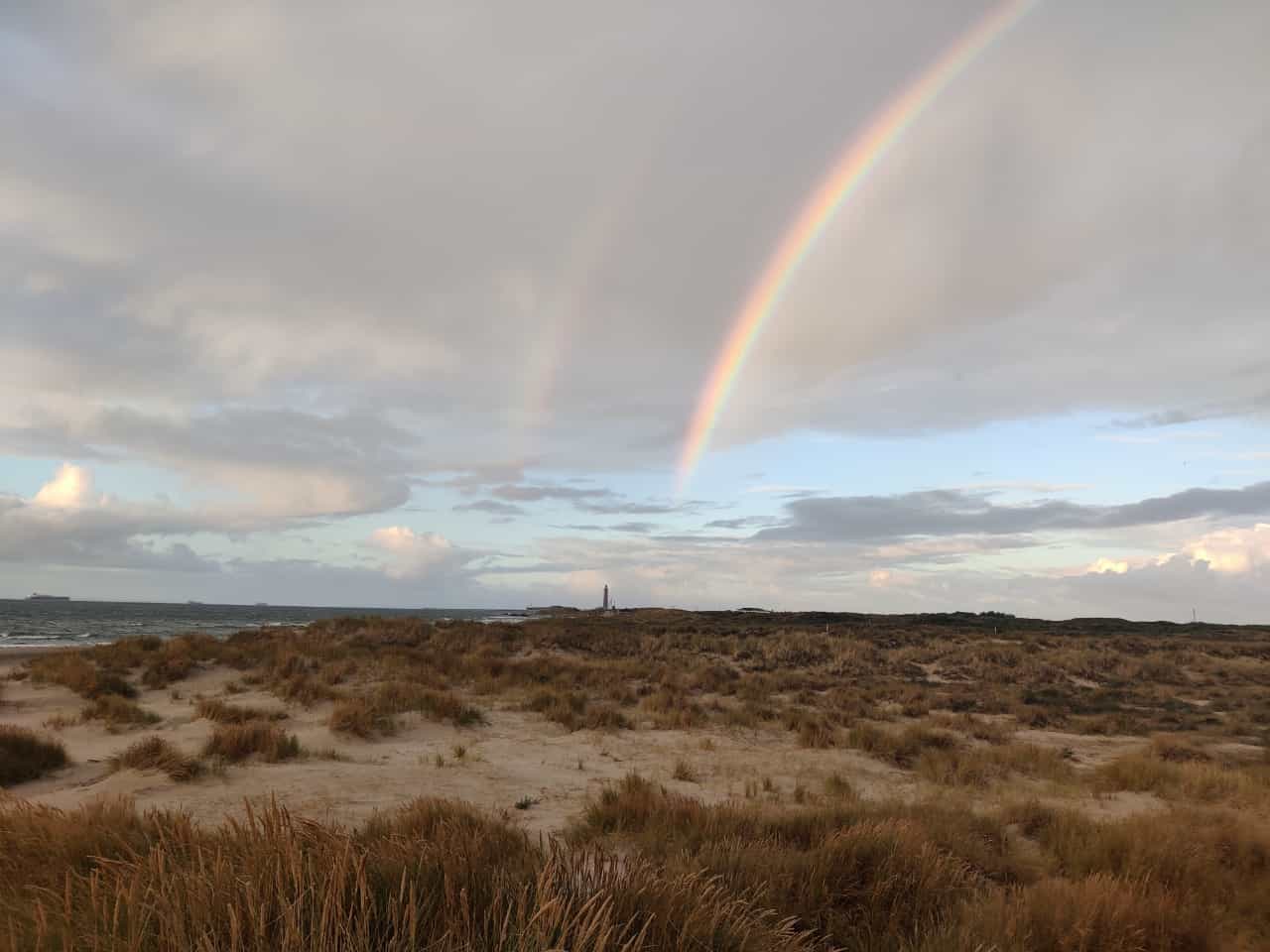
The morning's winds were still quite high and would usually result in postponing the ringing, however, with the school group still here and with birds and ringing to see, me and Hanelie opened as usual, with a few of the most exposed nets remaining closed. After the first 2 round we had already caught a good number of birds following a similar trend as seen in the last couple of days, which are, thankfully, much improved from the last two weeks numbers of birds caught each morning. At around 8am however the rain had started, and we rushed around temporarily closing the nets we had open and waited for it to pass as we sheltered in the tent, we have down at the ringing site. A privilege, I might add, that cannot be said for the unfortunate observers out at Worlds End 3 who felt the full force of the winds and the rain out on the dunes. At around 9:30, more rain was forecasted and for a longer period, so with the birds slowing, we closed and sent the wet student back to their tents for some lunch and to prepare for their afternoon tasks.
As mentioned previously, the poor observers out on the dunes felt the full force of the wind and the rain, but it was not all in vain. The highlight of the morning was the Corys Shearwater (Kuhls Skråpe), first spotted by Diana and then seen by others. It’s a rare bird here in Skagen but not too unexpected following the high winds we have had here in the last few days, so it was a good spot, and we will be on the lookout for more in the following days! Some other highlights from the morning were some Skuas, high numbers of gannets, and a Merlin (Dværgfalk) resting on the beach.
Peter Kristensen also paid the station a short visit and worked with Simon about fixing and setting up the radio mast that will allow us to record movements of radio tagged birds that pass within 15km radius of the mast.
Kristin and Carl, our current guests, bravely went for a swim just down past the lighthouse. I hope that when I am 90yrs old, I will also still be able to take swims in the sea and live life just as full as Carl as I’m sure the rest of do also.
Ringing (Kabeltromlen)
ChiffChaff/ Gransanger: 2
Blackcap/ Munk: 12
Lesser Repoll/ Lille Gråsisken: 1
Dunnock/ Jernspurv: 1
Robin/ Rødhals: 3
Redstart/ Rødstjert: 3
Wren/ Gærdesmutte: 1
Blackbird/ Solsort: 1
Total: 24
People at the Station: Frank Osterberg, Solenn Boucher, Diana Sciandra, Simon Christiansen, Lisa Vergin, Hanelie Sidhu, Martina Hillbrand, Peter Kristensen and our guests Kristin and Carl.
Busy day at the ringing table
Hi everyone!
Today has been a busy Monday, since the first hours of the day we lived many exciting moments.
Hanelie was the volunteer in charge of the night’ rounds; tonight we were hoping to catch Storm Petrels (Lille stormsvale) and Nightjars (Natravn) mainly, but instead we ringed other interesting birds: Sanderling (Sandlober) and a Turnstone (Stenvender)! We also caught a Dunlin (Almindelig ryle), which was a recapture from the previous week. I woke up every time Hanelie found a bird in the nets so I was not able to get a regenerating night but instead I saw my first Turnstone in the hand. Me and Hanelie were amazed by the little feet of this bird.
In the morning me and Frank went ringing at Kabeltromlen and luckily we have been helped since the very first round at the nets by a group of Martina’s students: we caught in total 69 birds!
We are very glad the students were so interested in our work; they made very intriguing questions and they learned a lot about bird ringing (some of them were almost able to age Robins - Rødhals).
Besides the enjoyable presence of the student this morning was a very productive one: the numbers of the birds ringed were very good and there were interesting species among them, like an Eurasian Treecreper (Nordlig Træløbe) and a Water Rail (Vandrikse; see the picture below), which is not a very easy bird to find in the nets (I had to run to take it before it could fly away).
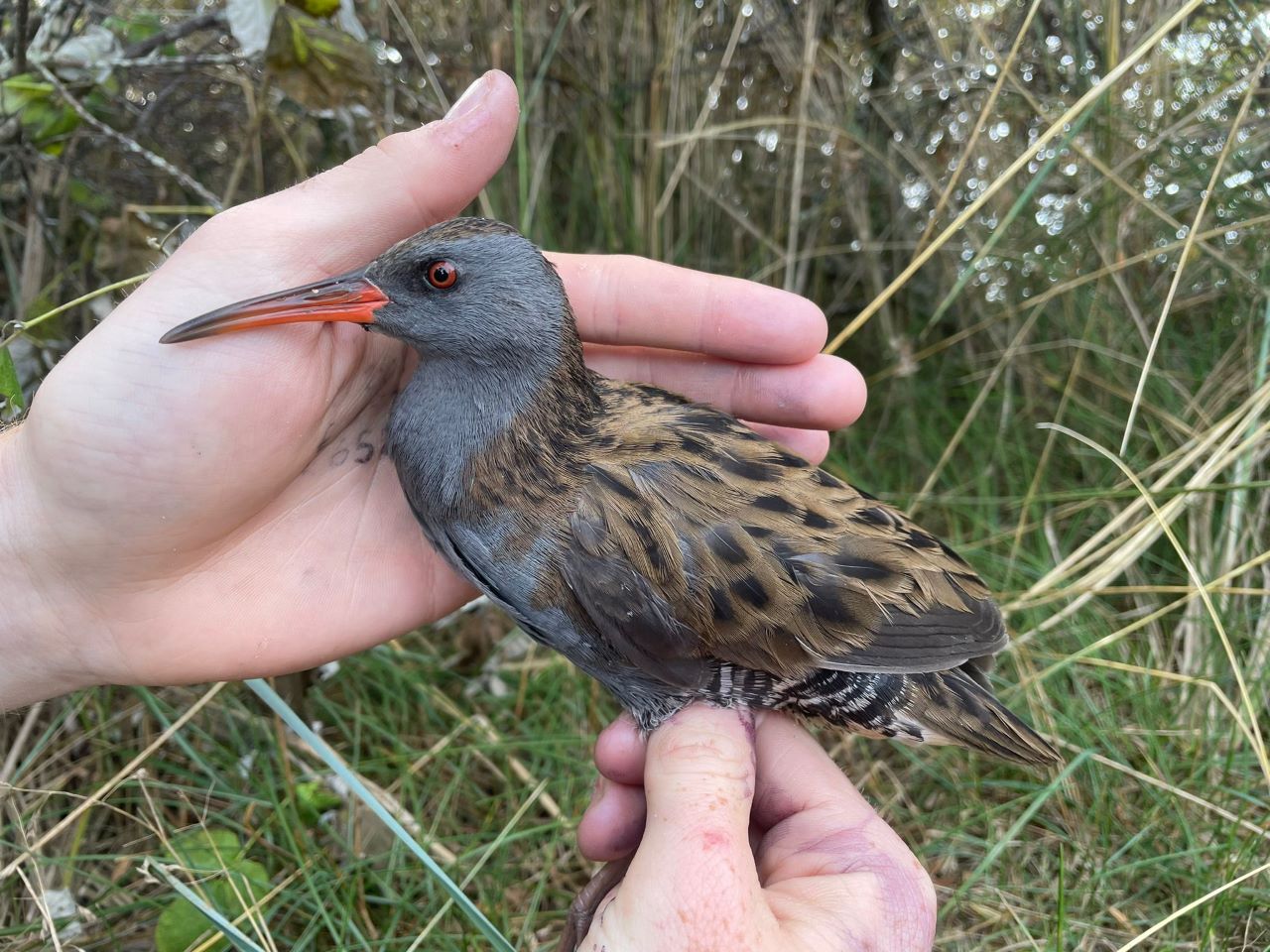
The other group of students went observing with Solenn and also wrote down a little text which I think can be shared here to help you understand what they feel about their school-trip:
“Our biology-course is visiting the Skagen Fugle Station on a school-trip for a few days. We were separated into groups of five to take part in the research-activities exerted by the Fugle Station, so we are able to get more knowledge of study-methods and the behavior, environment and migration of birds.
After waking up at 5:30 in the morning to be at the beach for sunrise, our group got binoculars and two telescopes. We went to the beach to watch birds migrating. Wind blowing, sun rising, cold faces and warm torsos, we walked through fields of sea buckthorn and beach grass until we reached the point where North sea and Baltic sea meet. Solenn was already there, sitting in the dunes, counting birds, and we sat down to join her. The air was cold and it got freezing, but the seagulls gathering on the sand, greasing their feathers, and the gannets, wheeling over the waves, waiting to flash down and catch fish, eiders swimming in low water and scoters flying just above the surface of the sea, were beautiful to watch. Despite the cold and the little-sleep circumstances, it felt really special and calming to just sit there to watch and identify birds, concentrating on binoculars and migrating strategies for hours.”.
After lunch we teached the students how to enter the data we take on birds (both on observing and ringing) and in the late afternoon we had a very good surprise: Lisa managed to catch a Magpie (Husskade; the picture below shows its beautiful tail)! This species is usually difficult to catch because of its dimensions and because of its intelligence.
I can't wait to see which other wonderful species I will see tomorrow...
Goodnight
Birds ringed at Gråfyr:
Sandløber (Sanderling) 1
Stenvender (Ruddy Turnstone) 1
Birds ringed at Kabeltromlen:
Jernspurv (Dunnock) 2
Rødstjert (Common redstart) 7
Rødhals (Robin) 15
Broget Fluesnapper (Pied Flycatcher) 1
Rørsanger (Reed Warbler) 3
Løvsanger (Willow Warbler) 2
Gransanger (Chiffchaff) 3
Fuglekonge (Goldcrest) 1
Munk (Blackcap) 17
Havesanger (Garden Warbler) 1
Tornsanger (Common Whitethroat) 4
Gærdesanger (Lesser Whitethroat) 3
Blåmejse (Blue tit) 4
Musvit (Great Tit) 1
Gærdesmutte (Eurasian Wren) 1
Grå Fluesnapper (Spotted Flycatcher) 1
Lille Dompap (Bullfinch) 1
Vandrikse (Water Rail) 1
Nordlig Træløber (Eurasian Treecreeper) 1
Birds ringed at Skagen By:
Husskade (Eurasian Magpie) 1
Total: 72!
People: Diana Sciandra, Solenn Boucher, Simon Christiansen, Lisa Vergin, Frank Osterberg, Hanelie Sidhu, Martina Hillbrand and our guests Kristin and Carl.
Todays Observations from the area on DOFBasen
Short visitor
Hello all, I am here again for a short visit. I arrived late last night and Simon kindly picked me up from the station – to tell me that I was to open the nets today. Which, of course, I gladly did – who needs sleep after all. Mind you, last time I was here in July, we were leaving at 3:30 or so to open the nets, today it was 5:15 so that feels like the Sunday it was.
So we opened the nets and since I wasn’t here for a couple of months I had no idea what to expect but I was hoping to catch a goldcrest (fuglekonge) because I only ever ringed one once in my life. It took less than two hours before I got my first of the day – which was later followed by two more. Such amazing and really pretty birds they are! With a weight of 5,5 grams, migrating several thousand kilometers from Sweden to the Mediterranean to winter there.
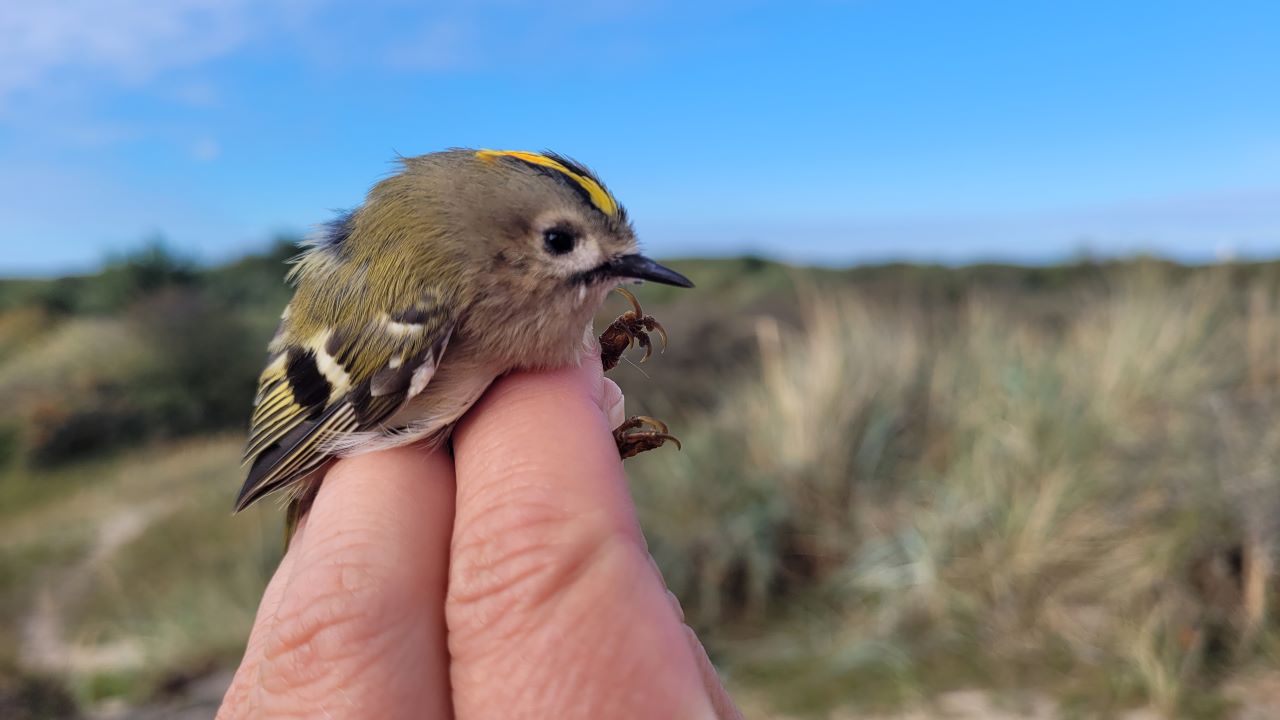
But we had other birds as well, of course, not only tiny goldcrests. We also had some very fat blackcaps (munk), who are clearly ready for a long trip – although they do not migrate any further than the goldcrest, they do so with a weight of 22 grams or more (after putting on fat – lean weight is around 17 grams). Next to that we also had quite a few common redstarts (rødstjert), mostly juvenile but also one very pretty adult male (not that the females are not pretty). And finally we also had three of a flock of siskins (grønsisken).
Rather special birds of today also were a sedge warbler (sivsanger) and a pied flycatcher (broget fluesnapper).
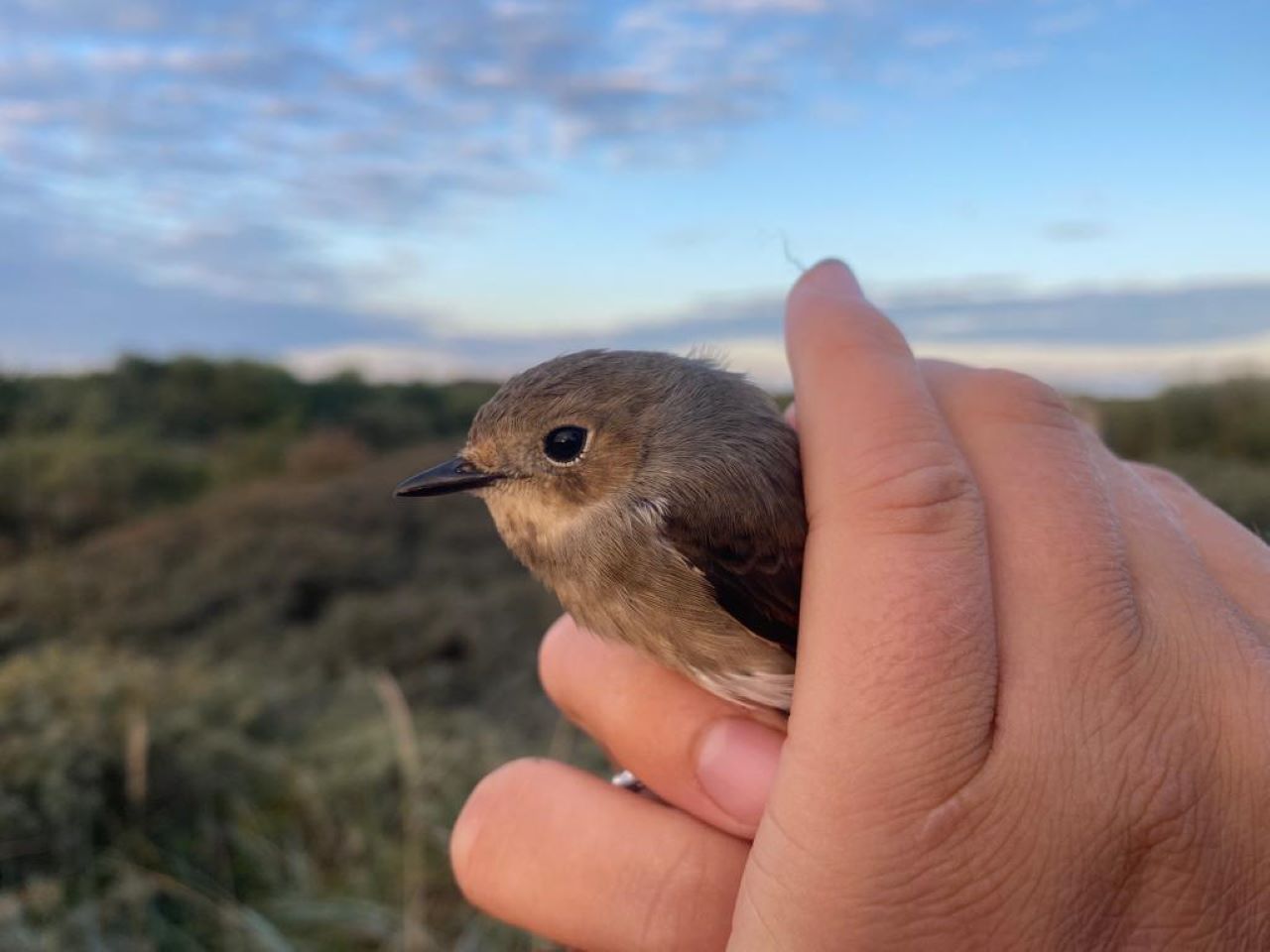
All in all, the ringing at Kabeltromlen was very good with a stunning 64 birds ringed today and very diverse today and lots of fun. I also got to know Hanelie and Solenn and we practiced our skulling skills which will come in handy for each of us in the future.
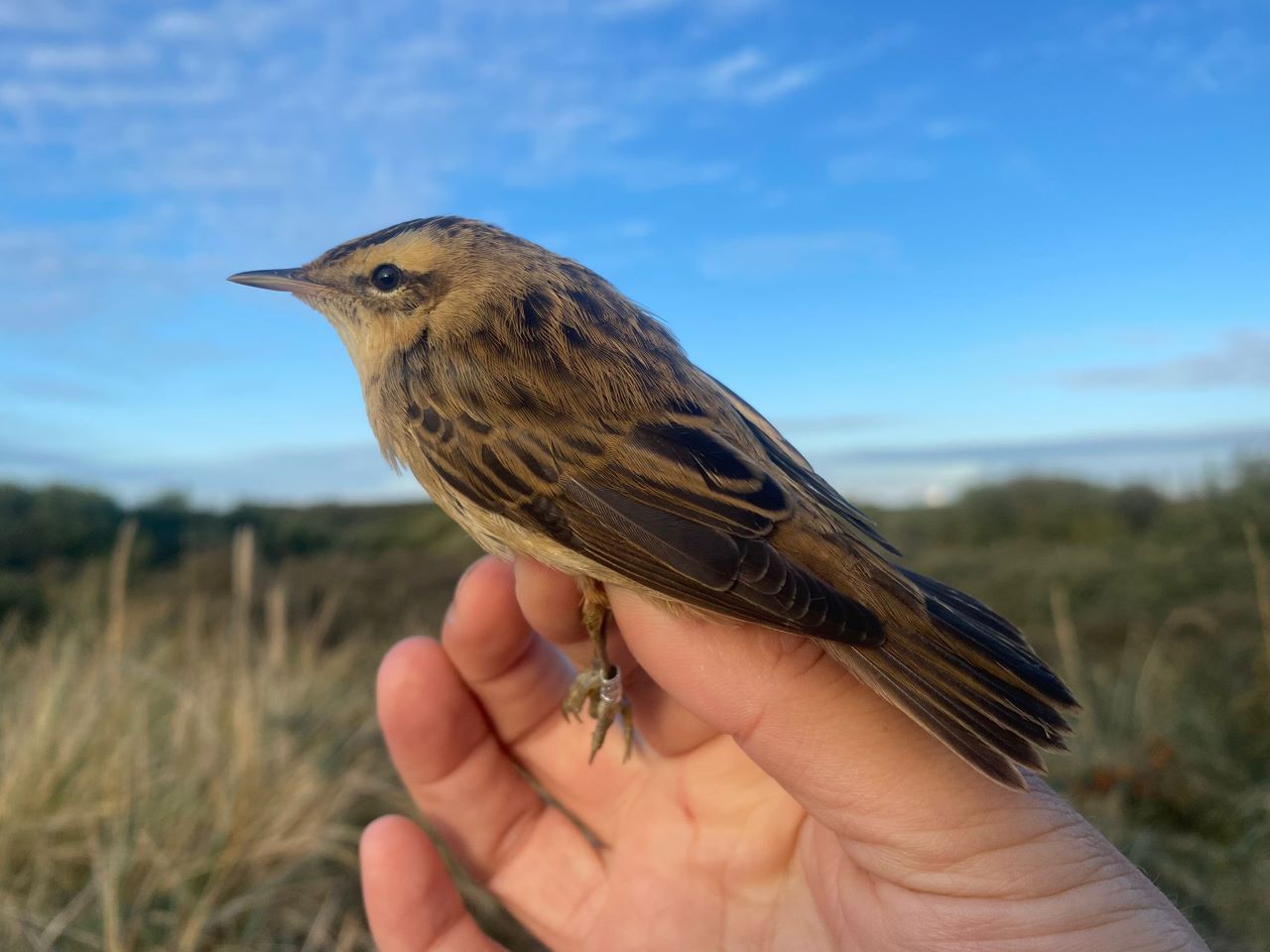
In the meantime, Frank and Diana were out observing at World’s End 3, while Max slept in and left at 10 for his long journey back to California where his semester at university will start in a week. Maybe we will see him again next year.
Also today our guests of this week left - maybe we will see them again next year as well. And late at night, our new guests for the next week will arrive.
Frank and Diana also had a good morning at the observations – Diana more so than Frank, who was very unhappy that he just missed the white-billed diver that was flying over while he was packing up his scope. Diana, on the other hand, saw her first ever black guillemot which made her day. There was also a black-throated diver and a red-throated pipit, next to a red-footed flacon and the usual birds.
In the afternoon, Simon went with the rest of the volunteers to fix the fence around the radio receiver still hoping to get updates from birds passing with a radio tag on.
At the same time, I went to the camp ground to meet my school class, which is the real reason that I am here (contrary to what you might think, this is not a fun visit, but I am actually here for work). 20 of my 12th and 13th grade students arrived this afternoon to spend the next 4 days in the area helping with bird work and doing some more biological field work on their own. My goal is, of course, to get them excited about birds an biological field work in general, and for them the goal is to get a good preparation for their final exam where one topic is ecology. I hope that some of them will write the blog in the days to come so you can read first hand what they are experiencing.
And while the best preparation for a tough week to come might be sleep for some, we chose to get prepared by spending a night catching birds, so again tonight we will try to catch more storm petrels (or whichever petrels really). We will report tomorrow how it went.
So far so good, it is my first and will probably be my last blog for this very short visit but I promise I will be back in the winter because I really want to see (and ideally ring) a snow bunting…
Birds ringed at Kabeltromlen:
Solsort (Blackbird) 1
Jernspurv (Dunnock) 3
Rødstjert (Common redstart) 6
Rødhals (Robin) 2
Broget Fluesnapper (Pied Flycatcher) 1
Rørsanger (Reed Warbler) 4
Sivsanger (Sedge Warbler) 1
Løvsanger (Willow Warbler) 2
Gransanger (Chiffchaff) 6
Fuglekonge (Goldcrest) 3
Munk (Blackcap) 14
Havesanger (Garden Warbler) 2
Tornsanger (Common Whitethroat) 5
Gærdesanger (Lesser Whitethroat) 2
Blåmejse (Blue tit) 6
Musvit (Great Tit) 1
Grønsisken (Siskin) 3
Rørspurv (Reed Bunting) 2
Total: 64!
People: Solenn Boucher, Max Laubstein, Simon Christiansen, Frank Osterberg, Hanelie Sidhu, Diana Sciandra and Martina Hillbrand
